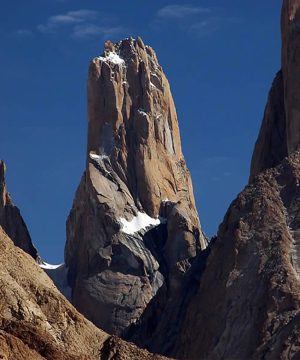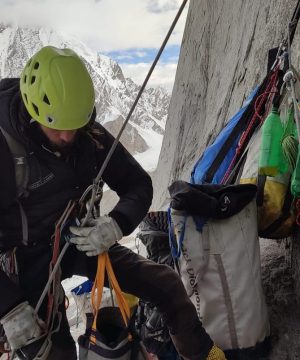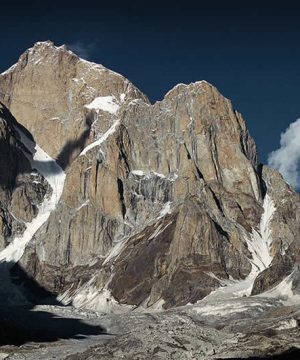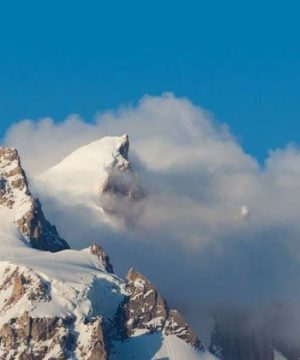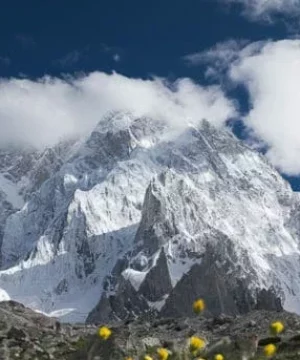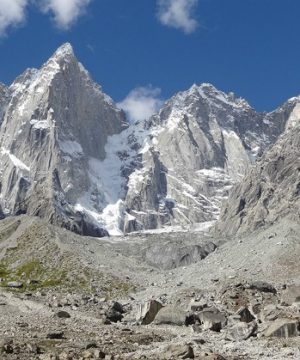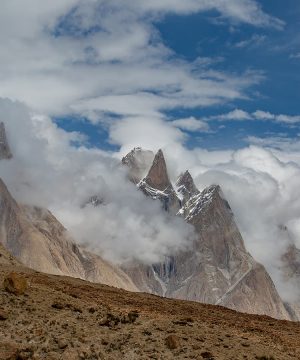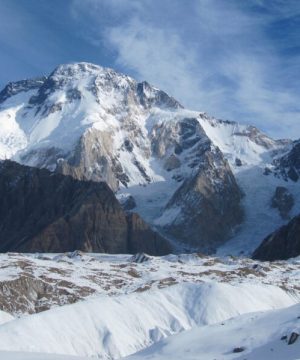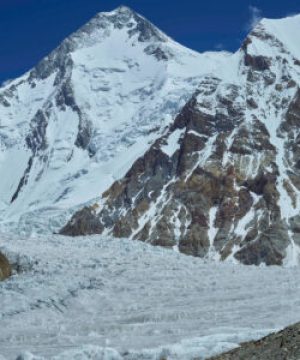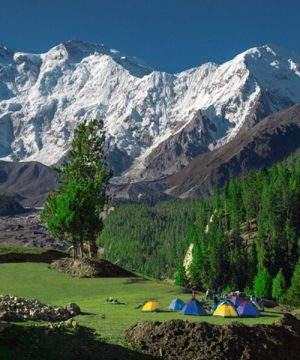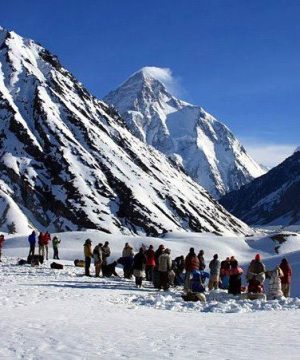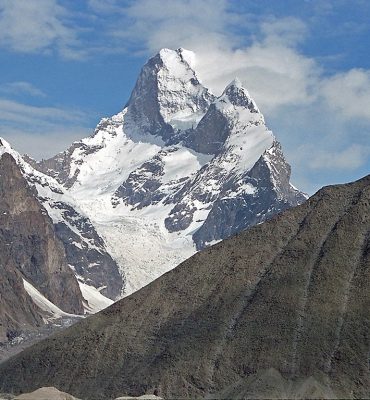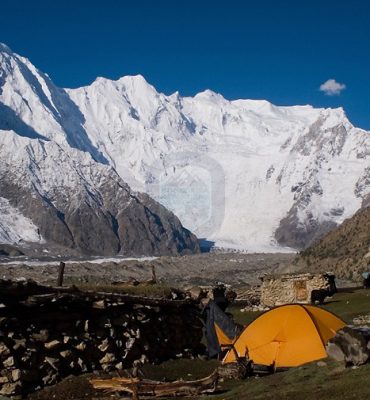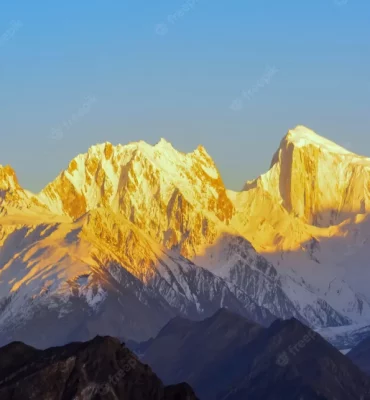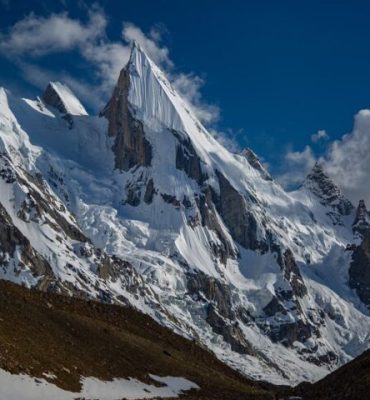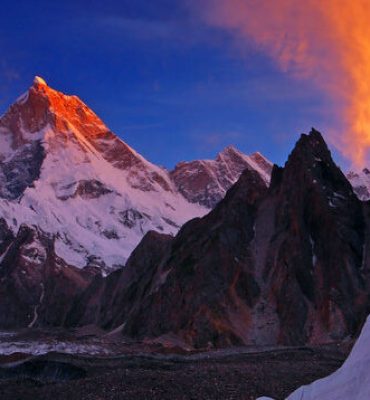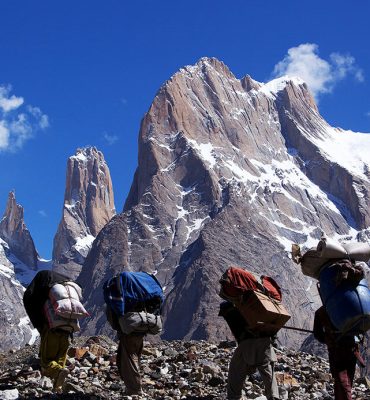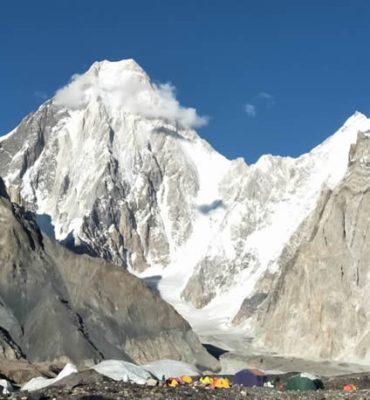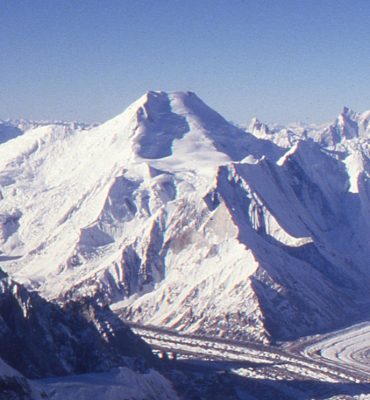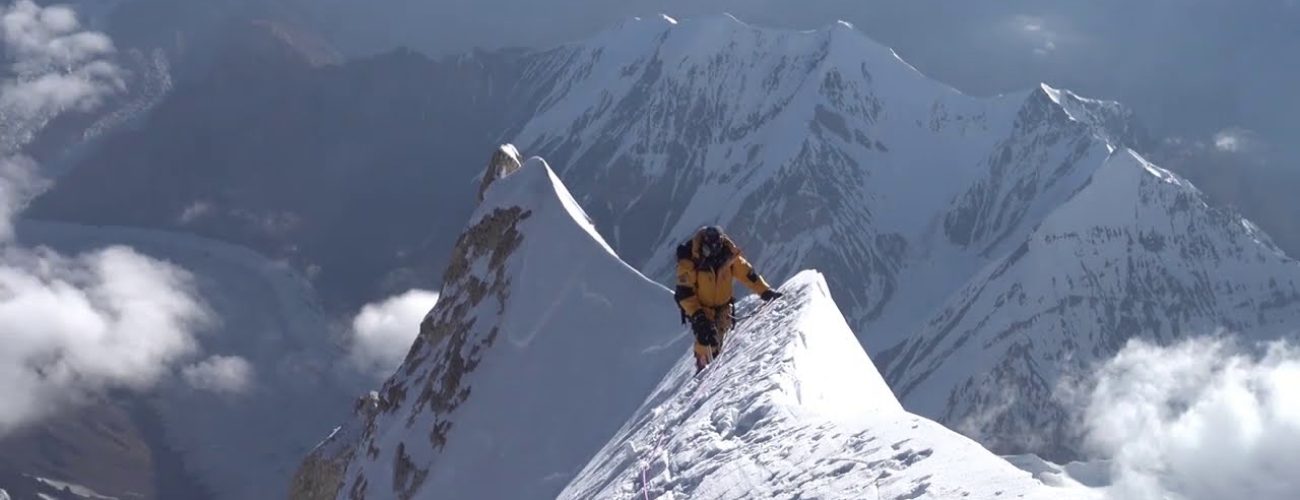
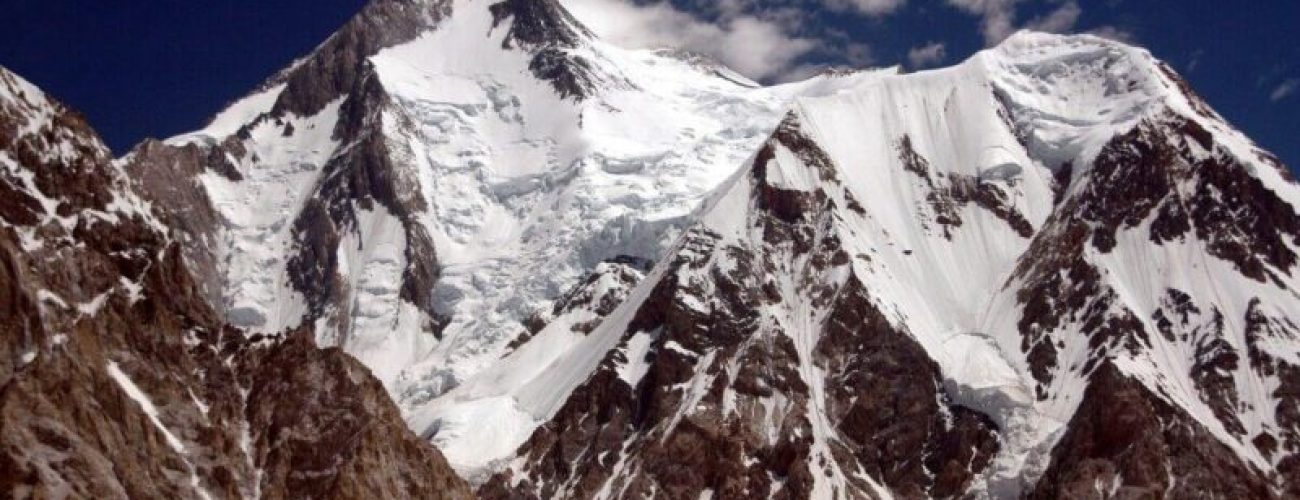

Gasherbrum-I-Expedition
Gasherbrum I-“Ultimate Adventure & Mountain Climbing Experience”
Gasherbrum I, also known as the “Hidden Peak”, is the 11th highest mountain in the world, rising to a breathtaking 8,080 meters (26,509 feet) above sea level. It is part of the Gasherbrum Massif located in the Karakoram Range in the remote, rugged expanse of Gilgit-Baltistan, Pakistan. This mountain offers an extraordinary mountaineering challenge—a beautiful, remote peak with fewer crowds and one of the most rewarding ascents in the high Himalayas.
Why is it Called the Hidden Peak?
The name “Gasherbrum” comes from the Balti words “rgasha” (beautiful) and “brum” (mountain), meaning “beautiful mountain.” However, GI earned the nickname “Hidden Peak” because of its remoteness and how it remained obscured from view for early explorers.
Discovered in the 19th century and first climbed in 1958 by an American team led by Nicholas Clinch, Gasherbrum I is known for its technical difficulty, icy terrain, and stunning panoramic views of the Karakoram.
Climbing Route & Camps
The standard route to Gasherbrum I is via the Gasherbrum La and the Northwest Face. It involves:
Base Camp (~5,000m)
Camp I (~5,900m) – Easy glacier terrain
Camp II (~6,400m) – Crevasses and fixed rope sections
Camp III (~7,000m) – Steeper ice and snow slopes
Summit Push – High-altitude climb with alpine exposure
This expedition requires ice climbing skills, crevasse navigation, and high-altitude experience, making it ideal for those who have already summited peaks above 6,000 or 7,000 meters.
Expedition Services & Inclusions
✅ Permit acquisition & government liaison
✅ Domestic flights or ground transport
✅ High-altitude porters & base camp staff
✅ Group and individual tents at base camp
✅ Meals (BC + high camp rations)
✅ Experienced high-altitude guides
✅ Fixed ropes & climbing support
✅ Satellite phone for emergency
✅ Medical and evacuation plan
Who Can Join?
Gasherbrum I is not for beginners. This expedition is recommended for:
Climbers with prior 6000m+ or 7000m+ experience
Alpinists with technical climbing background (ice axe, crampon use)
Mountaineers aiming to complete all 8000ers
Adventure filmmakers & expedition documentarians
Trekking teams for Baltoro & Concordia (optional)
Risks & Safety
Like all 8000ers, GI presents significant hazards:
Altitude sickness
Extreme cold & frostbite
Crevasses and icefall zones
Avalanches and serac collapse
Unpredictable weather
Safety Tips:
Climb high, sleep low (acclimatization rotation Hydrate and eat well at altitudeFollow guide instructions strictlyCarry a personal first aid and headlampAlways have emergency evacuation insurance
Scenic Beauty & Photography
Gasherbrum I offers views of:
K2, Broad Peak, GI, GII, and Gasherbrum IV
Serene landscapes of Baltoro Glacier
Towering rock faces of Trango Towers en route
Camps bathed in golden morning light
The haunting beauty of Concordia skies
Perfect for photography, adventure vlogging, and documentary content.
Expedition Itinerary
| Day | Activity |
|---|---|
| 1–2 | Arrival in Islamabad, expedition briefing |
| 3–5 | Travel to Skardu via flight or road |
| 6–8 | Drive to Askole, trek preparation |
| 9–15 | Trek from Askole to Gasherbrum Base Camp via Baltoro Glacier |
| 16–40 | Acclimatization, climbing rotations, summit attempt |
| 41–45 | Return trek to Askole and drive to Skardu |
| 46–47 | Debriefing in Islamabad |
Note: Itinerary may vary based on weather and team performance.
start planning your mountain expedition! |
Price P/P for the year 2025-26 ( all the prices are negociable)
Solo. $10000:- or €10000:- P/P
2 to 03 Pax $9000:- or €9000:- P/P
04 to 06 Pax. $8500:- or €8500 P/P
07 to 10 Pax. $8000:- or €8000 P/P
More than 10 Pax $7500:- or €7500P/P
Frequently Asked Questions (FAQ) – Gasherbrum I Expedition | The Hidden Peaks Expedition, Baltoro Glacier, Gilgit-Baltistan
Welcome to the FAQ section of Chogholinsa Trek & Tours Pakistan. Here, we answer your most common questions about the legendary Gasherbrum I Expedition (also known as The Hidden Peaks Expedition) in the breathtaking Baltoro Glacier of Gilgit-Baltistan. Whether you’re an experienced mountaineer or a curious adventure seeker, find all the essential information here.
1. What is Gasherbrum I?
Gasherbrum I, also called Hidden Peak, is the 11th highest mountain in the world, standing at 8,080 meters (26,509 feet). Located in the Karakoram Range of Gilgit-Baltistan, Pakistan, it is part of the Gasherbrum massif and is renowned for its challenging technical climbs and stunning alpine scenery.
2. Why is it called “The Hidden Peaks”?
The name “Hidden Peak” originates from its remote location and the fact that, for many years, it remained obscured from view due to surrounding mountains. The name also reflects the mountain’s challenging and elusive nature, making it one of the most sought-after peaks for elite mountaineers.
3. What does the Gasherbrum I expedition involve?
The expedition involves high-altitude mountaineering, technical climbing, glacier travel, and acclimatization in one of the most awe-inspiring environments in the world. It typically includes trekking through the Baltoro Glacier, establishing multiple camps, and a summit push with technical climbing in snowy and icy conditions.
4. Who is this expedition suitable for?
This expedition is suitable for highly experienced mountaineers with prior high-altitude and technical climbing experience. Participants should be physically fit, acclimatized, and prepared for extreme weather conditions.
5. How long does the expedition take?
The entire expedition usually takes around 6 to 8 weeks, including travel, acclimatization, the climbing phase, and contingency days. The typical schedule includes trek-in to base camp, acclimatization rotations, technical climbing, and descent.
6. What is the best time to undertake the Gasherbrum I expedition?
The most favorable climbing window is during June to August, when weather conditions are relatively stable, and temperatures are less extreme.
7. What are the main challenges of climbing Gasherbrum I?
- Extreme altitude and risk of altitude sickness
- Technical ice and snow climbing
- Unpredictable weather and high winds
- Crevasse crossings and glacier travel hazards
- Physical and mental endurance required for prolonged high-altitude exposure
8. What permits and documentation are required?
Participants need to acquire the necessary climbing permits from the Gilgit-Baltistan authorities. Our team handles permit procurement, and climbers must also carry valid passports, visas, and travel insurance covering high-altitude mountaineering.
9. What gear is required for the expedition?
- High-altitude mountaineering boots and crampons
- Ice axes, harnesses, carabiners, and ropes
- Insulated jackets, thermal layers, waterproof shells
- Sleeping bags rated for extreme cold
- Personal essentials like sunglasses, sunscreen, headlamps, and first aid kit
10. How physically fit should I be to join the expedition?
Participants should have prior high-altitude experience, be in excellent physical condition, and capable of enduring long hours of trekking, climbing, and altitude acclimatization. Training and preparation well before the expedition are highly recommended.
11. What is included in the expedition package?
Our package typically includes:
- Permits and official documentation
- Guiding and logistical support from experienced mountaineers
- Food and camping equipment during the trek and climb
- Assistance with gear and equipment
- Transportation from Gilgit to the base camp and back
12. Do I need travel insurance?
Yes. Travel insurance covering high-altitude mountaineering, emergency rescue, and medical evacuation is mandatory for all participants.
13. How can I prepare for the expedition?
Start a fitness regime focused on endurance, strength, and altitude training. Gain high-altitude experience through smaller climbs and trekking. Consult with our experts for personalized training advice.
14. How can I book my spot on the Gasherbrum I expedition?
Contact Chogholinsa Trek & Tours Pakistan to discuss your experience level, preferred dates, and itinerary. We will guide you through the booking process and help you prepare for this extraordinary adventure.
16. Who can I contact for more information?
Feel free to reach out to us through our contact page, email, or phone. Our expert team is here to assist you in planning your high-altitude expedition in Gilgit-Baltistan.
Embark on the adventure of a lifetime and conquer one of the world’s most iconic peaks with Chogholinsa Trek & Tours Pakistan.
Would you like me to add specific safety tips, technical climbing details, or testimonials?
More beautiful and rare climbed peaks
→Makrong Chhish expedition Price per person fromus$ 2,990 Makrong chhish expedition 2025-26 Makrong chhish peak registration is open for all seasons. For more info — contact us
a→ k7 peak expedition ↓ Price per person from us $ 2,990 K7 peak expedition 2022-26 k7 peak registration is open for all seasons. We are offering k7 peak for more info—
contact us ↵
→ Gul lasht zoam expedition ↓Price per person fromus$ 2,990 Gul lasht zom expedition 2025-26 mountain/peak price (usd) laila peak – haramosh (6,986m) 4200 k7 more info
contact us ↵
→ Choricho peak expedition↓ Price per person from us $ 2,990 Choricho peak expedition 2022-23 Choricho peak registration is open for all seasons. We are offering more info—
acontact us ↵
→ Buni Zom expedition ↓ Price per person from us $ 2,990 Buni zom expedition 2022-23 mountain/peak price (usd) laila peak – haramosh (6,986m) 4200 k7 peak more info—
contact us ↵
→Dut sar expedition ↓Price per person fromus$ 2,990 Dut sar expedition 2025-26 Dut Sar Peak registration is open for all seasons. We are offering more info—-
contact us ↵
→ Ghenta Peak Expedition ↓Price per person from US $ 3,690 Ghenta Peak Expedition 2025-26 Ghenta Peak registration is open for all seasons. We are offering for More info
contact us
→Bojohaghur Duanasir Expedition ↓ Price per person from US $ 3,690 Bojohaghur Duanasir Expedition 2025-26 Bojohaghur Duanasir Peak registration is open for all seasons More info—
CONTACT U
→ Pamri Sar Expedition ↓Price per person from US $ 3,690 registration is open for all seasons. We are offering Pamri Sar for more info—-
CONTACT US ↵
→Link Sar Expedition ↓Price per person fromUS$ 3,690
Link Sar Expedition 2022-23 Link Sar Peak registration is open for all seasons. We are offering Link Sar for more info—-
CONTACT US ↵
→K12 Peak Expedition ↓Price per person from US $ 3,690
K12 Peak Expedition 2022-23 K12 Peak registration is open for all seasons. We are offering K12 Peak More info—-
CONTACT US ↵
→Istor-o-Nal Expedition ↓Price per person from US $ 3,690 Istor-o-Nal Peak Expedition 2025-26 Mountain/Peak Price (USD) Malubiting Peak (7,458m) 420 for more info–
CONTACT US ↵
→Yazghil Sar Expedition ↓Price per person fromus$ 3,690 Yazghil Sar expedition 2022-23 Yazghil sar peak registration is open for all seasons. We are offering for more info —-
contact us ↵
→Kunyang Chhish Price per person from US $ 3,990 Kunyang Chhish Expedition 2025-26 Kunyang Chhish registration is open for all seasons. We are offering More info
CONTACT US ↵
→ Batura Sar Expedition ↓Price per person from US $ 3,990 Batura Sar Peak Expedition 2025-26 Batura Sar registration is open for all seasons. We are offe More info
CONTACT US ↵
→ Mitre Peak Expedition ↓Price per person from US $ 2,390 Mitre Peak Peak Expedition 2022-23 Mitre Peak Peak registration is open for all seasons. We are offering More info—
CONTACT US ↵
→ Spantik Expedition ↓Price per person from US $ 4,200 Spantik Expedition 2022-23 (Karakoram) Spantik Expedition registration is now open. We are offering More info
CONTACT US ↵
→Baltoro Kangri Expedition ↓Price per person from US $ 3,690 Baltoro Kangri Expedition 2022-26 Baltoro Kangri Peak registration is open for all seasons. We are o More info
CONTACT US ↵
→Yukshin Gardan Sar Expedition ↓Price per person from US $ 3,990 Yukshin Gardan Sar Expedition 2025-26 Yukshin Gardan Sar Expedition registration is open for all season More info—-
CONTACT US ↵
→ Shispare Expedition ↓ Price per person from US $ 3,990 Shispare Expedition 2025-26 Shispare Peak registration is open for all seasons. More info—-
CONTACT US ↵
→ Gasherbrum Expedition (I & II) – Karakoram ↓10 / 10 Price per person fromUS$ 10,900Gasherbrum Expedition (I&II) 2025-26 (Karakoram) Gasherbrum Expedition registration is now open. More info
CONTACT US ↵
→Gasherbrum II Expedition – Karakorum ↓ Gasherbrum II Expedition 2025-26 (Karakorum) Gasherbrum II Expedition registration is open for more info—-
CONTACT US ↵
→ K2 Expedition – Karakorum ↓ 10 / 10 K2 Expedition 2025-26 (Karakorum) K2 Expedition registration is now open. Climbing K2 is considered More info—-
CONTACT US ↵
→ Sangemarmar Sar Expedition ↓ Price per person from US $ 2,990 Sangemarmar Sar Expedition 2025-26 Sangemarmar Sar registration is open for all seasons. We are offering for More info—-
CONTACT US ↵
→ Phuparash Peak Expedition ↓ Price per person from US $ 2,990 Phuparash Peak Expedition 2025-26 Phuparash Peak registration is open for all seasons. For more info—-
CONTACT US ↵
Ghamubar Zom Expedition ↓ Price per person from US $ 2,990Ghamubar Zom Expedition 2022-23 Mountain/Peak Price (USD) Laila Peak – Haramosh (6,986m) 4200 K7 More info
CONTACT US ↵
→ Ganalo Peak Expedition ↓ Price per person fromUS$ 2,990 Ganalo Peak Expedition 2025-26 Ganalo Peak registration is open for all seasons. For More info—-
CONTACT US ↵
→ Chongra Peak Expedition ↓ Price per person from US $ 2,990 Chongra Peak Expedition 2022-23 Chongra Peak registration is open for all seasons. We are offering More info—-
→ CONTACT US ↵
→ Biarchedi Peak Expedition ↓ Price per person fromUS$ 2,990 Biarchedi Peak Expedition 2025-26 Biarchedi Peak registration is open for all seasons. We are offering More info
CONTACT US ↵
→ Beka Brakai Chhok Expedition ↓ Price per person fromUS$ 2,990 Beka Brakai Chhok Expedition 2025-26 Beka Brakai Chhok Peak registration is open for all season More info
CONTACT US ↵
→ Angel Sar Expedition ↓ Price per person from US $ 2,990 Angel Sar Expedition 2025-26 Angel Sar Peak registration is open for all seasons. We are offering An More info
CONTACT US ↵
→ Udren Zom Expedition ↓ Price per person from US $ 3,690 Udren Zom Expedition 2022-23 Mountain/Peak Price (USD) Malubiting Peak (7,458m) 4200 K12 Peak for more info—–
CONTACT US ↵
→ Akher Chhish Expedition ↓ Price per person from US $ 3,690 Akher Chhish Expedition 2025-27 Mountain/Peak Price (USD) Malubiting Peak (7,458m) 4200 K12 Peak More info —-
CONTACT US ↵
→ Snow Dome Expedition ↓ Price per person from US $ 3,690 Snow Dome Expedition 2025-26 Snow Dome Peak registration is open for all seasons. We are offering Sn More info
CONTACT US ↵
→ Skil Brum Expedition ↓ Price per person from US $ 3,690 Skil Brum Expedition 2025-26 Skil Brum Peak registration is open for all seasons. We are offering Sk More info—-
CONTACT US ↵
→Lupghar Sar Expedition ↓ Price per person from US $ 3,690 Lupghar Sar Expedition 2022-23 Lupghar Sar registration is open for all seasons. We are offering Lupghar Sar for More info—–
CONTACT US ↵
→Malubiting Peak Expedition ↓Price per person from US $ 3,690 Malubiting Peak Expedition 2025-26 Malubiting Peak registration is open for all seasons. We are offering More info—-
CONTACT US ↵
→ Muztagh Tower Expedition ↓Price per person fromUS$ 3,690 Muztagh Tower Expedition 2025-26 Muztagh Tower registration is open for all seasons. We are offering More info
CONTACT US ↵
→ Pumari Chhish Expedition ↓ Price per person fromUS$ 3,690 Pumari Chhish Expedition 2025-26 Pumari Chhish Peak registration is open for all seasons. We are offering More info—-
CONTACT US ↵
→ Passu Sar Expedition ↓ Price per person from US $ 3,690 Passu Sar Expedition 2025-26 Passu Sar registration is open for all seasons. We are offering Passu Sar More info—-
CONTACT US ↵
→Noshaq Peak Expedition ↓ Price per person from US $ 3,690 Noshaq Peak Expedition 2022-23 Mountain/Peak Price (USD) Malubiting Peak (7,458m) 4200 K12 Peak ( More info—-
CONTACT US ↵
→ Link Sar Expedition ↓ Price per person from US $ 3,690 Link Sar Expedition 2025-26 Link Sar Peak registration is open for all seasons. We are offering Link More info—-
CONTACT US ↵
→ Haramosh Peak Expedition ↓ Price per person from US $ 3,690 Haramosh Peak Expedition 2025-26 Haramosh Peak registration is open for all seasons. We are off More info
→ CONTACT US ↵
→Hachindar Chhish Expedition ↓ Price per person from US $ 3,690 Hachindar Chhish Peak Expedition 2025-26 Hachindar Chhish Peak registration is open for all seasons. More info
CONTACT US ↵
→ Ghent Kangri Expedition ↓
Price per person from US $ 3,690 Ghent Kangri Expedition 2022-23 Ghent Kangri Peak registration is open for all seasons. We are offering for More info—-
CONTACT US ↵
→Shispare Expedition ↓ Price per person fromUS$ 3,990 Shispare Expedition 2025-26 Shispare Peak registration is open for all seasons. We are offering Shispare More info—–
CONTACT US ↵
→ Chogolisa Expedition ↓ Price per person from US $ 3,990 Chogholingsa Expedition 2022-23 Chogholingsa Peak registration is open for all seasons. We are offering Chogholingsa peak for More info—-
CONTACT US
→Kanjut Sar Expedition ↓ Price per person from US $ 3,990 Kanjut Sar Expedition 2022-23 Kanjut Sar Peak registration is open for all seasons. We are offering More info
CONTACT US ↵
Gasherbrum I Expedition – Karakoram. Price per person from US $ 8,900 Gasherbrum I Expedition 2025-26 (Karakoram) Gasherbrum I Expedition registration is now open. We are offering for More info
CONTACT US ↵
→ Masherbrum Expedition ↓ Price per person from US $ 3,990 Masherbrum Expedition 2022-23 Masherbrum Peak registration is open for all seasons. We are offering More info—–
CONTACT US ↵
→ Baintha Brakk Expedition (The Ogre) ↓ Price per person from US $ 3,690 Baintha Brakk Expedition 2025-26 Baintha Brakk Peak registration is open for all seasons. We are offering for More info
CONTACT US ↵
→ Gasherbrum V Expedition ↓ Price per person from US $ 3,690 Gasherbrum V Expedition 2025-26 Gasherbrum V Peak registration is open for all seasons. We are offer More info
CONTACT US ↵
→ K6 Peak Expedition ↓ Price per person from US $ 3,690 K6 Peak Expedition 2022-23 K6 Peak registration is open for all seasons. We are offering K6 Peak for More info
CONTACT US ↵
→ Trivor Peak Expedition ↓ Price per person from US $ 3,990 Trivor Peak Expedition 2025-26 Trivor Peak registration is open for all seasons. We are offering More info
CONTACT US↵
→ Skyang Kangri Expedition ↓ Price per person from US $ 3,990 Skyang Kangri Expedition 2025-26 Skyang Kangri Peak registration is open for all seasons. More info
CONTACT US ↵
→Latok I Expedition ↓ Price per person from US $ 3,690 Latok I Expedition 2022-23 Latok I Peak registration is open for all seasons. We are offering Latok More info—
CONTACT US ↵
→Broad Peak Expedition ↵ Price per person from US $ 11,500 Broad Peak Expedition 2022-23 (Karakoram) Broad Peak Expedition registration is now open. We are offering for More info
CONTACT US ↵
→Koyo Zom Expedition ↓ Price per person from US$ 2,990 Koyo Zom Expedition 2022-26 Koyo ZomPeak registration is open for all seasons. We are offering Koyo More info—– contact Us
→Paiju Peak ↓Paiju Peak Expedition Price per person from US $ 2,990 Paiju Peak Expedition 2025-26 Paiju Peak registration is open for all seasons. We are offering Paiju More info—–Contact
→Latok II ExpeditionPrice per person from US $ 3,690 Latok II Expedition 2025-26 Latok II Peak registration is open for all seasons. We are offering for more info—-
Contact Us
→Crystal Peak Expedition Price per person fromUS$ 2,390 Crystal Peak Expedition 2025-26 Crystal Peak registration is open for all seasons. We are offering More info—-
Contact Us
→ Honbrok Peak Expedition ↓ Price per person fromUS$ 2,390 Honbrok Peak Expedition 2022-23 Honbrok Peak registration is open for all seasons.We are offering for More info—–
CONTACT US ↵
→ Darmyani Peak Expedition↓Price per person fromUS$ 2,390 Darmyani Peak Expedition 2022-23.registration is open for all seasons. We are offering More info —- CONTACT US ↵
→ Chikar Zom Expedition ↓Price per person fromUS$ 2,390 Chikar Zom Expedition 2022-23.Chikar Zom Peak registration is open for all seasons. We are offering More info—–
CONTACT US ↵
→ Uli Biaho Expedition ↓Price per person fromUS$ 2,390 Uli Biaho Expedition 2022-23 Uli Biaho Peak registration is open for all seasons. We are offering More info—–
CONTACT US ↵
→Trango Tower Expedition↓ Price per person fromUS$ 2,390 Trango Tower Expedition 2022-23 Trango Tower Peak registration is open for all seasons. We are offer More info—-
CONTACT US
→ Shayaz Zom Expedition ↓Price per person fromUS$ 2,390 Shayaz Zom Expedition 2022-23 Shayaz Zom Peak registration is open for all seasons. We a More info—–
Contact Us ↵
→ Lobsang Peak Expedition ↓ Price per person fromUS$ 2,390 Lobsang Peak Expedition 2022-23 Lobsang Peak registration is open for all seasons. We are offering for More info—-
CONTACT US ↵
→ Gama Sokha Lumbu Expedition ↓ Price per person fromUS$ 2,390 Gama Sokha Lumbu Expedition 2022-23 Gama Sokha Lumbu Peak registration is open for all seasons. We are offering for more info More info—–
CONTACT US ↵
→Urdukas I Expedition ↓ Price per person fromUS$ 2,390 Urdukas I Expedition 2022-23 Urdukas I Peak registration is open for all seasons. We are offering Ur More info—-
CONTACT US ↵
→ Ultar Sar Expedition ↓ Price per person from us $ 3,690 Ultar sar expedition 2022-23 ultar sar peak registration is open for all seasons. We are offering for more info—→
Contact Us ↵
→Kampire Dior Expedition ↓Price per person from us $ 3,69 Kampire dior expedition 2025-26 kampire dior peak registration is open for all seasons. We are offering more info—
→contact us ↵
→ Sangemarmar Sar Expedition ↓ Price per person from us $ 2,990 Sangemarmar sar expedition 2025-26 sangemarmar sar registration is open for all seasons. We are offering for more info—- contact us ↵
→Karun Kuh Expedition ↓ price per person from us $ 2,990 Karun kuh expedition 2025-26 karun kuh peak registration is open for all seasons. We are offering for more info
Contact us ↵
→Ghamubar Zom Expedition ↓Price per person from $ 2,990 Ghamubar zom expedition 2025-26 mountain/peak price (usd) laila peak – haramosh (k7 more info
Contact us ↵
→ Rashphari Peak Expedition ↓ Price per person from us $ 2,990 rhuparash peak expedition 2025-26 rhuparash peak registration is open for all seasons. We are offering more info——
Contact us ↵
→ Laila Peak Expedition (Haramosh) ↓ price per person from us $ 2,990laila peak expedition 2025-26 laila peak registration is open for all seasons. We are offering Laila Peak more info——– contact us ↵
→ Vigne Peak Expedition↓ price per person from us $ 2,990 Vigne peak expedition 2025-26 vigne peak registration is open for all seasons. We are offering vigne Peak more info—–
Contact us ↵
→ Balti Peak Expedition ↓ Price per person from us $ 2,390. Balti peak expedition 2025-26 balti peak registration is open for all seasons. We are offering balti Peak more info—–
Contact us ↵
→ Miar Peak Expedition ↓ Price per person from us $ 2,990 Miar peak expedition 2025-26 Miar peak registration is open for all seasons. We are offering miar peak more info—-
Contact us ↵
→Thui Zom Expedition↓ Price per person from us $ 2,990 Thui zom expedition 2025-26 Thui Zom Peak registration is open for all seasons. We are offering Thui more info
Contact us ↵
→Seiri Porkush Expedition ↓ Price per person from us $ 2,990 Seiri porkush expedition 2025-26 Seiri Porkush Peak registration is open for all seasons. We are offring more info—–
Contact us ↵
8000+ meters
World Rank | Rank (Pakistan) | Name | Height (m) | Location |
2 | 1 | K2 Expedition | 8611 | Karakoram |
9 | 2 | Nanga Parbat | 8126 | Himalaya |
11 | 3 | Gasherbrum I (K5) | 8080 | Karakoram |
12 | 4 | Broad Peak | 8051 | Karakoram |
13 | 5 | Gasherbrum II (K4) | 8035 | Karakoram |
7000 to 8000 meters
6000 to 7000 meters[edit]
5000 to 6000 meters[edit]
Pakistan islamabad rawalpindi lahore karachi punjab sindh peshawar gilgit hunza skardu shigar khaplu hushe askole nanga parbat k2 broad peak gashabrum I gashabrum II
Call: +92-344-5447525
WhatsApp: +92-3355-5223795
Eid Ghaah Colony Skardu Gilgit-Baltistan Pakistan
info@chogholingsa.com tongorpa33@yahoo.com

@2022 Chogholingsa – All Rights Reserved
